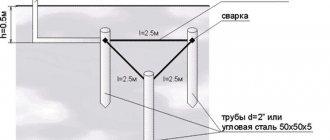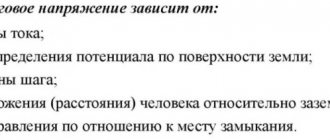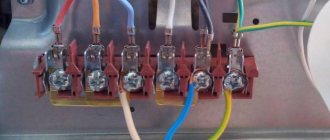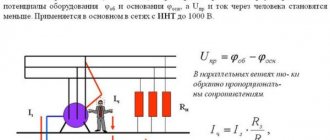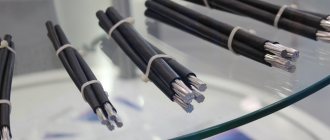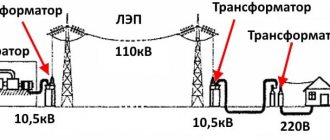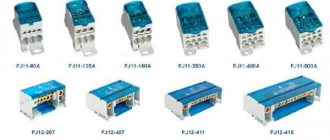To protect people in everyday life when they come into contact with an electrical device, the body of which has experienced a breakdown of electric current, there are 2 main options that differ from each other in terms of operation and conditions of use - this is connecting the ground or zero. Grounding is the transfer of current to the electrical panel with subsequent shutdown of the machine, and grounding is the removal of current to a grounding circuit in the ground without stopping the current supply. Let's look at what both protection schemes are, what their fundamental differences are, as well as how, when and in what way you can make zeroing in a private house.
A protected socket has 3 contacts - phase, neutral and neutral or grounding Source sense-life.com
Grounding
The transfer of electric current from the body of electrical equipment to a special circuit physically immersed in the ground is called protective grounding. A pair of conductors is supplied to each household appliance from the electrical panel - phase and neutral. Phase breakdown on a metal body (boiler, washing machine, radiator, etc.) poses a potential threat to the health and life of household members.
To prevent this, the device body is connected with a special insulated conductor to a ground loop. Due to this, during a phase breakdown, the electric current will simply go into the ground - along the path of least resistance. Therefore, even in the worst-case scenario, even if a person receives an electric shock from contact with faulty electrical equipment, it is completely safe for health.
There are 3 main options for how to perform grounding, the arrangement of which is carried out separately, without the use of grounding circuits:
- Professional . It is used to ensure uninterrupted operation of industrial installations in normal or emergency mode.
For reliable grounding in the courtyard of the house, a special circuit is made in the ground Source vodatyt.ru
- Household . Used to protect people at home during phase breakdown on the surface of electrical equipment.
- Spontaneous . Designed to protect devices from powerful current discharges that occur when struck by lightning.
In addition, protective grounding circuits are classified according to their origin into 2 types:
- Artificial . This is a specially made structure connected by conductors to electrical appliances. Angles, fittings, rolled pipes, and wires are used as components. They are distinguished by the maximum degree of reliability and fully perform their functions.
- Natural . It is a household structure that can act as a grounding loop. These can be steel well casing pipes, water supply, sewerage or reinforced concrete parts of the structure. The main feature is that to ensure operability, special conditions must be met - the structure should not be aluminum or coated, moreover, flammable compounds should not pass through it.
Natural grounding on a steel pipe in a private house Source otoplenie-gid.ru
Important! Unlike grounding, the grounding system provides a continuous and more reliable drainage of electric current from the surface of a household electrical appliance directly into the ground. At the same time, the grounding circuit stops the supply of current only at the moment of its breakdown on the housing, by turning off this branch of the network by the monitoring equipment.
See also: Catalog of companies that specialize in electrical work of any complexity
Basic requirements for electrical safety
The main requirement for household electrical appliances is safety. This applies to a greater extent to devices that come into contact with water, because even a minor defect in the electrical wiring of the equipment can be fatal to the user. To protect yourself and others, it is necessary to keep the electrical network and equipment in good condition and regularly inspect them. To eliminate the possibility of a fire due to faulty wiring and electric shock, it is necessary to install protective devices (RCD).
In accordance with the basic electrical safety rules:
- The installation of temporary electrical wiring is not recommended.
- The connection of wires must be made by welding, crimping, clamping or terminal blocks. Regularly check the quality and strength of wiring connections.
- In areas with high humidity, use only certified waterproof devices.
- Electrical sockets and switches must be located at a distance of at least 500 mm from heating, gas and water supply pipes.
- Regularly check the condition of wiring and electrical equipment.
- Do not use any type of electrical equipment without a protective casing.
- Do not use homemade electrical appliances and do not repair faulty electrical equipment yourself.
This is just a short list of electrical safety requirements. More detailed information about safety rules can be found in various regulations and special literature on electricity, which are now easily found on the Internet.
Zeroing
When creating a protective grounding circuit, electrically conductive parts of equipment with which a person can constantly or accidentally come into contact are connected to the neutral conductor in the electrical panel. The principle of installation on the device itself is similar to the grounding circuit - only in this case, the contact on the body connected to the “ground” is connected to the “zero”. In both cases, protection is carried out using a separate conductor.
The operating principle of nulling protection is quite simple and boils down to the following algorithm:
- At the moment of phase breakdown on the housing or other conductive parts of the electrical device, the electric current is instantly transmitted by “zero” protection to the controlling module.
- A short circuit occurs at the point of contact between the “zero” of the electrical appliance and the phase.
Schematic difference between grounding and grounding Source tinkoffjournal.ru
- An electrical panel, fuse or other control equipment instantly cuts off the current supply in this part of the electrical circuit.
- As a result, the electrical appliance is de-energized, and the person is safe.
However, the main feature of such grounding is that the current generated during a protective short circuit and sent to the machine must be sufficient to trigger the equipment. Otherwise, the protection will be ineffective and people will be in danger. Moreover, the phase will begin to be distributed to other parts or electrical appliances also connected to the “zero” protection.
The difference between grounding and grounding
There are the following number of main differences between the two protection methods under consideration:
- Protection of the “ground” type diverts the current into the ground, and of the “zero” type into the electrical panel.
- The grounding conductor, by removing electric current from the device body, reduces the voltage to a value that is safe for humans. The neutralizing conductor leads current to the machine, which de-energizes a certain area without affecting the characteristics of electricity.
Grounding is more reliable and easier to manufacture at home than grounding Source electric-doma.ru
Distribution transformer - phase, zero (neutral)
To begin with, it is worth briefly familiarizing yourself with the path and methods of supplying voltage to the outlets in your home. The last intermediate link from which electricity enters your home is the distribution transformer.
Having received three phases from the generators at the power plant, the transformer reduces the voltage and transfers power from the secondary winding to the consumer through the phase and combined working and protective neutral (PEN) conductor.
Zero acts as a neutral, a beginning, and serves as the starting point for measuring voltage characteristics. It connects the phase windings in a star connection diagram. The potential at this point is zero. And the potential difference between phase and neutral corresponds to a phase voltage of 230 Volts.
Features of arranging grounding in the house
When arranging protection for electrical appliances across “zero”, a number of rules must be followed. First of all, it is necessary to correctly install the electrical circuit:
- One neutral conductor is supplied to the automatic distribution panel from the pole.
- It is further divided into two directions, each of which goes to its own bus.
- One of the cores becomes the working “zero” or neutral, the other becomes the neutral wire, the one that will provide protection.
- From the machine, the neutral is distributed to all electrical appliances for their normal operation.
- The neutral conductor is connected to the electrical panel housing. In this case, a conductor with a characteristic yellow-green sheath is used for connection, which typically indicates its protective function.
- The yellow-green core is connected to a similar one in the electrical wiring of the house and is then distributed to all sockets. Through them, the housings of all electrical appliances requiring protection will be connected to a common neutralizing system.
- After leaving the automatic protective equipment in the home, the standard neutral wire and the grounding wire are no longer in contact.
Wire insulation control
To prevent accidents from electric shock, it is necessary to monitor the insulation condition of electrical installation wires. The condition of wire insulation is checked in new installations, after reconstruction, modernization, or a long break in operation. Preventive control of wire insulation is carried out at least once every 3 years. The insulation resistance of the wires is measured with megohmmeters for a rated voltage of 1000 V in areas with the fuse-links removed and the pantographs turned off between each phase wire and the neutral working wire and between every two wires. The insulation resistance must be at least 0.5 MΩ.
Briefly about the main thing
Grounding is the removal of voltage from the housing of electrical equipment to the ground through a grounding loop. There are professional, household and spontaneous versions. It can be artificial, specially created, or natural, when suitable metal structures are used as current transmitters.
Grounding differs from grounding in that the electric current during a breakdown on the housing is diverted not into the ground, but into the distribution panel. This artificially causes shortening, as a result of which the machine is triggered and the equipment is de-energized. The main differences between them boil down to the following features:
- Grounding drains the current into the ground, and grounding into the shield.
- Grounding reduces the voltage on the case, grounding completely de-energizes the circuit.
- Making a grounding circuit is accessible to any more or less literate person; protection through “zero” can only be arranged by a professional.
- Protection through grounding is more suitable for industrial facilities, grounding - for residential ones.
Grounding in the house is suitable as a temporary measure until a full-fledged grounding loop is created in the yard. It is necessary to equip protection across the “zero” with careful selection of suitable conductors and compliance with electrical installation rules.
Application area
Protective grounding is used in electrical installations with four-wire electrical networks and voltages up to 1 kW in the following cases:
- in electrical installations with a solidly grounded neutral in networks TN-CS, TN-C, TN-S with conductors of types N, PE, PEN;
- in networks with direct current and a grounded midpoint of the source;
- in networks with alternating current and three phases with a grounded zero (220/127, 660/380, 380/220).
Networks 380/220 are allowed in any structures where grounding of electrical installations is mandatory. For residential premises with dry floors, there is no need to equip grounding.
Electrical equipment 220/127 are used in specialized areas where there is an increased risk of electric shock. Such protection is necessary in outdoor conditions, where metal structures touched by workers must be grounded.
